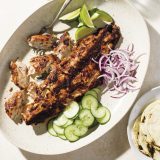It was predawn when we climbed out of the car in an empty parking lot after a long drive up from Jalisco to the coast of Nayarit. We headed to the boatyard as dawn slowly broke over the water, and I met Sebastián Renner, a local chef.
Renner had plenty of three-star chef experience in Europe but decided to move back to Mexico to live the good life. His small beachfront restaurant, Makai, is located next to a gas station, serving world-class food in a Margaritaville setting. (Renner often takes off a couple of hours to go surfing.)
This morning, however, we were going fishing. Well, I was going to troll for fish, while Renner and a friend were going wet-suit snorkeling with harpoon guns. Next to two 30-somethings in top shape who could hold their breath for two minutes, I felt like the aging teacher on the school outing—out of place, especially when I was shown a photo of a 500-pound marlin they’d once caught spearfishing and somehow dragged up onto the back of the small fishing boat. Much as with whaling, once you spear such a monster, you are in for a Nantucket sleigh ride—you may end up a mile or more out to sea. Though I used to be a skilled scuba diver, Renner and his friend were way out of my league.
After gifting a bucketful of fish to a friend back in the harbor, we then drove to Makai and had one of those rare culinary experiences when the food is unexpectedly divine, transcending the shorts-and-sandals setting. Renner specializes in fish cured like meat—dark slabs of tuna or ribbons of dried fish wrapped around creamy fillings, plus sashimi, tuna ceviche, aguachile rojo and manta ray croquetas. You also can order a hamburger or crab cakes at Makai, but what’s the point?
An early dinner followed at Restaurante Bar Fernando, a pleasant eatery with a classic outdoor courtyard, large brick grills under a corrugated roof and a singer accompanied by a boombox on songs such as “Brown Eyed Girl,” “Under the Boardwalk” and hits from the Bee Gees.
The specialty of the house—and this region—is pescado zarandeado. Snapper or similar fish is butterflied, brushed with a mixture of achiote, chilies, tomato paste, and soy sauce and/or Worcestershire sauce. It’s then cooked slowly over low heat, pressed into fish baskets set at a 45-degree angle to the grill—the coals are way past their prime—so that the fish turns meaty and dense without becoming dry. A final brushing of lime juice, butter and soy sauce also is common. This method concentrates flavor, and the marinade or basting sauce provides punch and helps keep the fish moist.
When reproducing zarandeado at Milk Street, we opted to use a low oven, since grilling thin fillets is tricky and this method prevents the fish from overcooking. To make the seasoning paste, we prefer achiote, but sweet paprika is a decent substitute; we also use ancho and guajillo chilies. Red snapper is the fish of choice (you want the skin on, as it helps hold the fillets together), but fluke or haddock fillets also work. We like to serve pescado zarandeado with lime wedges, cucumber, onion and, of course, warm tortillas.
At Restaurante Bar Fernando, the final song of the evening was “Te He Prometido,” a bittersweet classic that starts off, “I have promised you that I will forget you …knowing that tomorrow you will go to the altar with another.” That is, in short, the job of a food writer. You fall in love at every meal only to get up the next day and fall in love with another. Well, I thought, maybe this day was the one.
In Search of Pescado Zarandeado
Christopher Kimball

Get the Recipe
Slow-Cooked Snapper with Chili and Lime
In Nayarit, on Mexico’s Pacific coast, some chefs spearfish for dinner, while others specialize in a slow-cooking method called zarandeado







